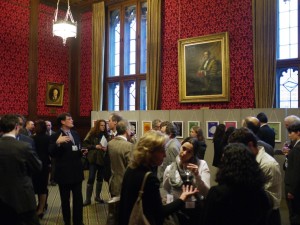An invitation arrived in my email box from the BioCentre in the UK for a nanotechnology workshop and reception featuring some ‘nanotechnology’ art work at the House of Lords. I was pleased to notice that the artist, Julie Freeman, was someone I met a few years ago at the 2009 International Symposium on Electronic Arts (ISEA) in Belfast. As attending the event was not possible, I decided to approach Julie for an interview and she kindly answered my questions.
Before launching into the interview, here’s a little more information about the BioCentre’s 2nd workshop in a series titled, Revolution, Regulation and Responsibilities; Technology & Democracy in the 21st Century (from the PDF) ,
Products, Privacy & People: Regulating on the Nanoscale Monday 28th February 2011, 14:00, House of Lords, Committee Room 3
The manipulation of matter at the nanoscale represents a ‘rebound revolution’ reframing our understanding and engagement with science and technology. As nanotechnologies continue to evolve the promised nano structures which offer novel and new properties currently present unknown hazards. Nanoparticles have been found to pass through the skin, offering exciting possibilities of targeted drug delivery. Conversely, given their size nanoparticles could also interfere with the functioning of proteins on the surface of cells, or be taken up into cells and bind to intercellular proteins. How crucial is public awareness of these issues? Should there be a mandatory labelling system for nano products? This becomes all the more important as nanomaterials are adopted commercially and taken up into global supply chains.
Nanotechnology will present new possibilities for collecting new data and intensifying debate and discussion surrounding ongoing questions of privacy. There is the potential for tiny senses to be embedded in clothes, products or even bodies which could record and collect a multitude of data, including the movement of people, products, health and financial details.
Increasingly, it appears that the distinction between human and machine could become blurred through the convergence of biology, nanotechnology, information technology and even neuroscience. If some of the grander ideas which nanotechnology would seemingly promise are believed to be true, then fusion between people and technology could occur like never before. Yet public and civil society debate remains limited despite dramatic efforts to frame the significance of such developments ranging from Eric Drexler’s ‘grey goo’ scenario, to technology guru Bill Joy’s Why the Future Doesn’t Need Us, to Ray Kurzweil’s imminent expectation of the sci‐fi “singularity”.
As attempts are made to develop effective and proportional regulation in response there is also the inevitable tension between divergent approaches to risk management on the national, regional and global level. One thing is for certain, transdisciplinary discussion, fresh thinking and understanding is essential if we are to avoid a repeat of the GM foods debacle and re‐emergence of the ‘yuck’ factor. Through short expert presentations, panel and Q&A discussions you are invited to join us as we discuss and examine the regulatory issues at the nanoscale.
A drinks reception will follow the symposium during which the work of Julie Freeman, Artist‐in‐residence at Microsystems and Nanotechnology Centre, Cranfield University, will be on display. [emphasis mine]
Now, here is the interview with Julie Freeman,
a) Which work (or works are) is being shown at the House of Lords on Feb. 28, 2011? [if you have any images of the piece or pieces, I would be happy to include them.]
A set of 16 A3 prints from the Nano Novel collection, which are part of the In Particular project.
(b) How did your work come to be selected for this display? Was it specifically created for this show or was it chosen as something that would be relevant to the workshop themes “of revolution, regulation and responsibilities surrounding the issue of emerging technologies?”
Each of the works are accompanied by two pieces of text, one factual, one fictional. The factual texts describe a process, issue or reaction that is related to the nanoscale, so although there is a broad range – from how nanoparticles are moved to the future of self-diagnostic implants – some of them address issues of regulation and revolution. The director of a UK think tank called BioCentre asked me if I would like to exhibit the work at the seminar. I had been previously asked to show work at a BioCentre event, but it was too complicated to install just for a few hours. As the Nano Novels work are framed prints they are the most portable piece of work I have ever created, so are ideal for an exhibition with a quick turnover!
(c) Could you discuss some of the challenges of representing the invisible (that which occurs at the nanoscale) and some of the specific challenges, technical and/or conceptual, that you encountered with the work being shown at the reception?
The work shown, as I mentioned, were digital prints. The prints are the first stage in the In Particular project, kind of a way for me to contextualise nanotechnology in a way that I could understand it. I have prototype works in progress that are proving tricky to realise – at the nanoscale materials take on different properties and behaviours. Stresses and strains that act at the macro level are different at the nanoscale so even creating something as seemingly simple as a rigid nanothin film is very complex. I think the challenge for artists working in the realm is how to avoid the obvious, how to depict something that is beyond our sensory perception, and how to create work that is true to a nanoprocess or material without simply showing it at a macro scale.
(d) How does someone with an MA in Digital Arts from the Lansdown Centre for Electronic Arts, Middlesex University, London come to be associated with the Microsystems and Nanotechnology Centre at Cranfield University?
I knew when I started my MA that I wanted to work with life and technology – life in terms of living biology. My MA show consisted of a fish tank containing 4 rudd that were tracked and created a soundscape (a precursor to a future larger project called The Lake**), so although it took ten years, it was a natural progression for me to end up working in a laboratory with scientists.
The residency was instigated by Professor Jeremy Ramsden, Chair of Nanotechnology at Cranfield University. He says “I’d read a very interesting book by Cyril Smith* in which he argues that the primary motivation for new technology was aesthetic” so he thought an artist on his team would push the technology in a new direction. He approached a local arts agency, HAPPEN, who had visited my work The Lake, which is another piece of work that involved much scientific collaboration, and they brokered the relationship. We quickly ascertained that we had a lot of common curiousity, so we collaborated on a funding proposal and were very fortunate to be successful.
*C.S. Smith, The Search for Structure: Selected Essays on Science, Art and History, MIT Press, Cambridge (Mass.) (1981).
**http://www.juliefreeman.co.uk/lake/
(e) What are you currently working on now (nanotechnology-influenced or not)?
I have been working on ideas that bring my love of data together with the bionanotech area, the fusion of biology and technology at the ‘invisible’ level. Consequently I’m working on some new kinetic objects that incorporate nanomaterials and utilise conversational network activity to give them dynamic actions. I can’t say much more, but it’s an ambitious one!
(f) Is there anything you’d like to add?
Thanks for being in touch. Great blog!
You’re welcome and glad you enjoy the blog.
You can find out more about Julie Freeman and her work at her website, Translating Nature.
ETA Mar. 8, 2011: Julie Freeman sent two pictures from her show at the House of Lords.
And then, the crowd arrived.

